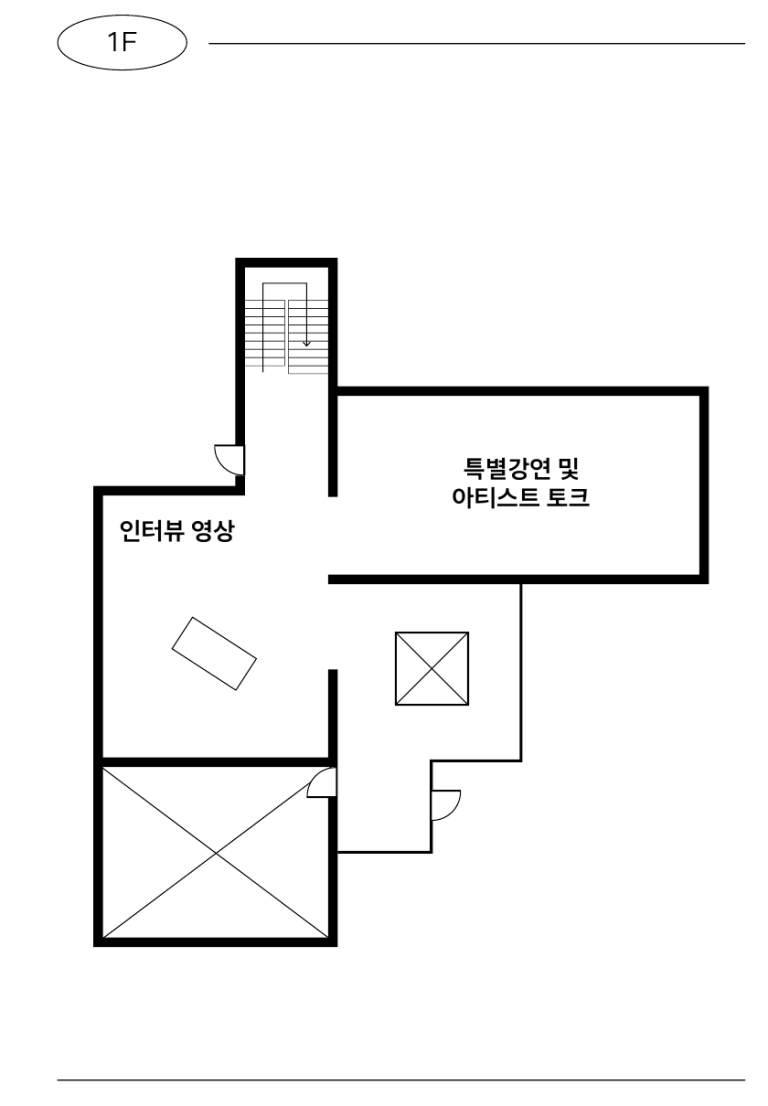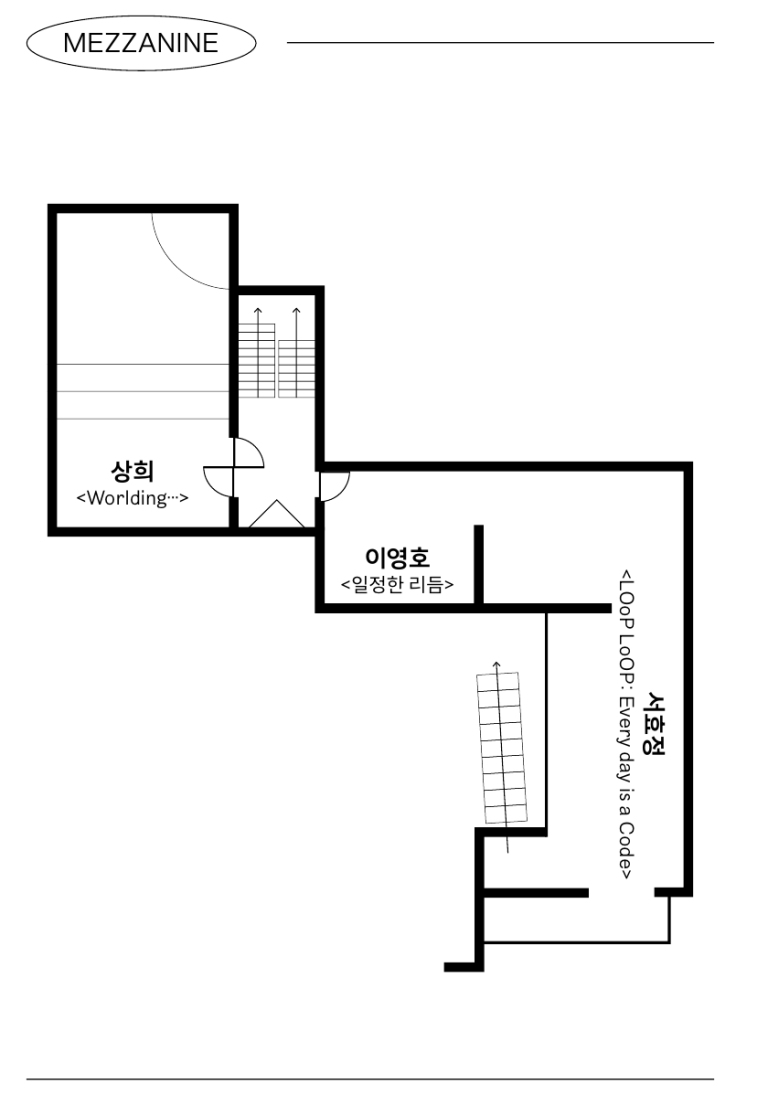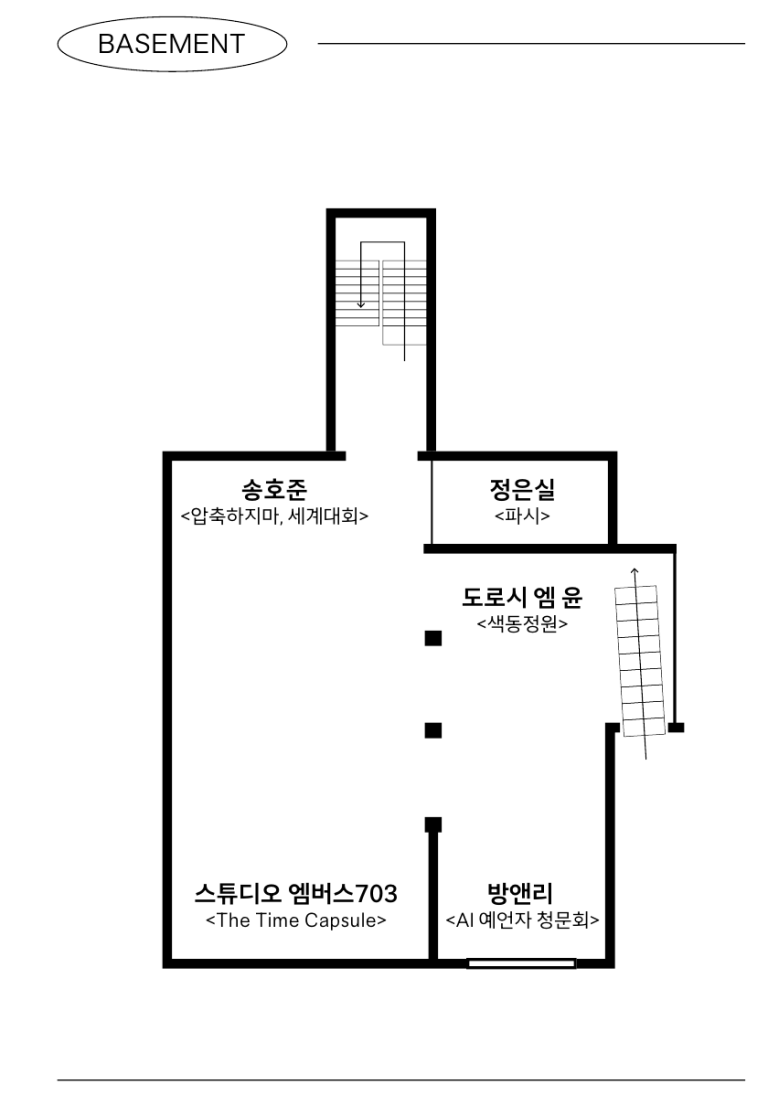예술은 끊임없이 변화를 거듭하며, 시대의 흐름과 함께 그 형태를 확장하고 재해석합니다. 《팩언팩(Pack-Unpack)》은 디지털 미술이 이러한 변화 속에서 어떻게 창작되고, 보존되며, 전시되는지에 대한 깊은 탐구를 담고 있습니다. ‘팩(Pack)’은 작품을 싸는 과정을, ‘언팩(Unpack)’은 그 작품을 풀어내어 전시하는 과정을 상징하며, 이 전시는 그 과정을 통해 디지털 미술의 복잡한 본질을 드러냅니다.
전통적인 회화와 조각은 완성된 형태로 전시장에 들어오며, 그 설치 과정에서 작품의 본질이 변하지 않습니다. 회화는 캔버스 위에 고정된 이미지로서, 그리고 조각은 공간을 차지하는 물리적 존재로서 관람객에게 전달됩니다. 이와 달리 디지털 미술은 기술과 장비에 따라 변화 가능한 특징을 지니고 있으며, 전시 공간의 조건에 따라 유연하게 변형될 수 있습니다. 《팩언팩》은 디지털 미술 작품이 만들어지고, 설치되고, 전시되는 과정을 탐구하며, 작품의 내부와 형성 과정을 투명하게 드러내고자 합니다. 그리고 그 모든 설치 과정의 순간을 예술적 경험으로 확장하고자 합니다.
The Beginning and End of the Exhibition :
Packing and Unpacking
Art is constantly evolving, expanding its forms, and being reinterpreted in response to the flow of the times. Pack-Unpack delves into how digital art is created, preserved, and exhibited amid these transformations. Here, “Pack” symbolizes the process of wrapping and preparing a work, while “Unpack” represents its unfolding and display. Through these processes, the exhibition aims to reveal the intricate nature of digital art.
Traditional paintings and sculptures enter the exhibition space in a finished form, with their essence remaining unchanged throughout the installation. A painting presents a fixed image on canvas to the viewer, while a sculpture occupies physical space as a tangible form. In contrast, digital art is adaptable to various technologies and equipment, allowing it to transform flexibly according to the conditions of the exhibition space. Pack-Unpack explores the creation, installation, and display of digital art, seeking to transparently reveal the inner workings and developmental processes behind each piece. The exhibition also aims to expand each moment of the installation into an artistic experience.
디지털 미술 전시란 무엇인가?
‘전시’라고 하면 밝은 단색의 면과 평면의 벽, 입방체 형식의 화이트 큐브 공간을 떠올릴 것 입니다. 하지만, 화이트 큐브 공간의 역사는 그리 길지 않습니다. 뉴욕현대미술관이 1936년 《큐비즘과 초상》이라는 전시를 통해서 최초로 화이트 큐브 전시 방식을 확립한 것으로 알려져 있으나, 개념에 대한 본격적인 논의는 1976년 미술비평가 브라이언 오 도허티(Brian O Doherty, 1928-2022)가 쓴 「하얀 입방체의 내부에서(Inside the White Cube)」라는 글을 통해서 구체화 되었습니다. 미술관이라는 전시 공간은 르네상스 때 시작되어 다양한 형식으로 변화해 왔으며, 오늘날의 화이트 큐브 공간은 모더니즘의 산물로 그 역사는 그리 길지 않습니다. 결과적으로 화이트 큐브 공간은 모더니즘 예술 작품들을 위한 공간이라 해도 과언이 아닐 것입니다.
그러나 모더니즘 이후 현대예술은 다양한 장르와 형식으로 지금까지도 다양한 변화를 꾀하고 있습니다. 스마트폰이 현대미술의 주요 매체가 되어 새로운 작품 감상의 툴로 사용되는가 하면, VR을 통해서 미술관 전시를 볼 수 있는 시대입니다. 그러나 이러한 예술을 담는 전시 방식은 화이트 큐브에서 블랙박스로 바뀌는 정도에 멈추어 있지 않나 생각해 봅니다. 전통적인 회화나 조각을 보여주었던 전시 방식은 또 한번의 변화가 필요합니다. 하여 《팩언팩》은 디지털 미술의 각양각색 전시 방식과 다양한 논의를 함으로써 디지털 미술을 어떻게 보여주고 판매, 유통할 것인가에 대해서 깊게 고민하고자 합니다.
What Is a Digital Art Exhibition?
When we think of an “exhibition,” the image of bright, monochrome walls and flat surfaces in a cube-shaped white space often comes to mind. However, the history of the white cube is relatively short. The white cube exhibition style is believed to have first been established by the Museum of Modern Art in New York in 1936 with the exhibition 《Cubism and Abstract Art》, but the conceptual discussion became more defined through art critic Brian O’Doherty’s 1976 essay ‘Inside the White Cube’. The museum as an exhibition space dates back to the Renaissance, undergoing various transformations over time, and the modern white cube is a product of modernism, with a relatively recent history. In many ways, the white cube was designed to showcase modernist artworks.
However, contemporary art has evolved into diverse forms and genres since the postmodern era. Today, smartphones have become essential tools for engaging with contemporary art, and it’s now possible to visit exhibitions through VR. Yet, the method of exhibiting such art seems to have only shifted from the white cube to the black box. Traditional exhibition formats, designed for paintings and sculptures, need to undergo another transformation. With Pack-Unpack, we explore new exhibition methods and engage in discussions about how digital art can be presented, sold, and distributed.
디지털 미술 어떻게 만들어지는가?
“우리가 미술작품을 감상할 수 있는 것은 어릴 때 한 번쯤 그림을 그려봤고, 조각을 해봤기 때문이라고 생각해요. 하지만, 미디어아트(디지털 아트)는 어떻게 만들어지는지 아무도 모르죠. 그저 완결된 작품만 전시장에 걸릴 뿐. 우리가 즐길 줄 알기 위해서는 만드는 내용과 과정에 대한 이해가 필요하다고 생각합니다”
— 미디어 아티스트 올라프 발(Olaf Val) 인터뷰 중에서
미디어 아티스트 올라프 발은 새로운 작품을 만들 때마다 다양한 워크숍을 만드는 작가로 잘 알려져 있습니다. 우리는 디지털 미술이 어떻게 만들어지는지에 대해서 알지 못합니다. 만들어진 결과물을 블랙박스나 LED 모니터에 전시할 뿐입니다. 《팩언팩》은 기존의 전시 형태에 대한 관행을 깨고, 작품이 만들어진 과정과 작품의 내부를 보여주고자 합니다. 결과물로서의 작품만을 ‘전시’하는 것이 아니라, 작품을 창작하기 위해서 작가가 참조한 책, 영화, 그리고 다양한 자료를 공개하려 합니다. 그뿐만 아니라 작품을 구성하는 장비와 부품, 제작 및 설치를 위한 테크니컬 라이더를 함께 비치하여 관객으로 하여금 작품을 보다 깊이 있게 이해할 수 있도록 돕고자 합니다.
디지털 미술 전시 기획에서 중요한 요소는 기술적 기반과 공간적 유연성입니다. 디지털 미술 작품은 각각 고유한 기술적 요구 사항을 가지고 있으며, 이를 충족시키기 위해 기획자는 각 작품의 테크니컬 라이더에 따라 설치를 준비합니다. 테크니컬 라이더는 작품 설치를 위한 기술적 지침서로, 작가가 현장에 없더라도 작품이 온전히 구현될 수 있도록 돕는 중요한 역할을 합니다. 이는 전통적인 회화나 조각 작품의 전시 준비 과정에서는 볼 수 없었던 디지털 미술 전시와 함께 등장한 새로운 요소이며, 디지털 미술 작품이 기술적 조건과 공간에 맞추어 조정되고 변형되는 과정을 안내하는 필수 요소입니다.
또한 디지털 미술의 핵심은 인터랙티브성과 몰입감을 바탕으로 관람객이 단순히 보는 것을 넘어 작품과 직접 상호작용을 하도록 이끈다는 점입니다. 대부분의 작품은 관객이 작품에 직접적으로 참여하거나 상호작용을 할 수 있는 방식으로 전시됩니다. 이를 위해서는 블랙박스와 같은 어두운 공간이나, AR(증강현실), VR(가상현실) 기술을 활용한 몰입형 공간이 필요합니다. 이러한 전시는 전통적인 화이트 큐브의 개념을 넘어서며, 각 작품이 최적의 환경에서 경험될 수 있도록 하는 공간적 유연성이 요구됩니다.
그리하여 전시장에 구성된 작품은 다양한 디지털 미술 형태로 존재하며, 각각의 작품은 전시 공간의 특성과 기술적 요건에 맞추어 설치되었습니다. 함께 제시된 테크니컬 라이더는 작품의 완전한 설치를 위한 지침서로 준비되었으며 설치된 작품은 이를 샘플링하거나 축소하여 그 일부를 보여주는 방식으로 구성하였습니다.
전시장에서 가장 먼저 만나는 작품, 이영호의 필름과 AR을 결합한 <일정한 리듬>은 아날로그 매체와 디지털 매제가 결합하여 작용하는 불협화음 즉, 조화와 부조화 사이의 어딘가를 표현하는 내용에 중점을 두고 형식적으로는 요점에 걸맞게 축소 설치하였습니다.
서효정의 <LOoP LoOP: Every day is a Code>는 공간과 여건에 따라 매우 유동적으로 변신할 수 있는 제너러티브 아트입니다. 현재 공간의 특성을 고려한 매체를 활용하여 재구성된 것이 특징입니다.
도로시 엠 윤의 AR 인터랙티브 작품 <색동정원>은 설치 환경은 축소되었지만, AR을 통해 작품의 핵심인 관객 참여, 몰입과 인터랙티브가 잘 드러날 수 있도록 구현하였습니다.
방앤리의 3채널 비디오 설치 <AI 예언자 청문회>는 스토리라인을 따라가는 것이 중요한 작품이기 때문에 몰입할 수 있는 환경을 고려하여 매체를 고민하고, 축소 설치하였습니다. 이를 통해 디지털 미술의 설치 방법을 좀 더 다양화하여 여러 곳에서 작품을 선보일 수 있는 방안을 모색하고자 하였습니다.
스튜디오 엠버스703의 메타버스 작품인 <The Time Capsule>의 경우 비교적 가장 최근에 두각을 나타내는 설치 방법을 구현하고 있습니다. 미술관은 전통적인 오프라인 공간을 넘어서 온라인 공간으로의 확장을 통해 다방위적 전시를 구현하고 있습니다. 인터넷 환경과 같이 온라인과 연동에 방점이 있는 메타버스 형식의 전시 방식을 잘 드러내려고 하였습니다.
정은실의 <파시>는 그 형식이 VR 애니메이션인 만큼 영화제 등 다양한 스크리닝 환경에서도 쉽고 탁월하게 작동할 수 있는 방법에 초점을 맞추었습니다. 작가가 실재하지 않더라도 작품의 복제가 훌륭하게 이루어질 수 있는 전시와 스크리닝 환경에 기여할 수 있는 방법이길 바랍니다.
송호준의 <압축하지마, 세계대회>는 여러 도시와 나라에서 같은 형식으로 진행되는 퍼포먼스/페스티벌 형태의 디지털 미술입니다. 퍼포먼스 방식과 절차를 잘 정리하는 것뿐만 아니라 그것을 디지털 미술로 변환하는 방법과 의의까지 정리하려고 노력하였습니다.
마지막으로 상희의 <Worlding···>은 개별 플레이가 끝난 이후에 사후적으로 플레이 데이터를 동기화하는 비동기 온라인 게임 형식을 차용한 참여형 VR 작품입니다. 그렇기에 온라인과 오프라인에서의 자체 설치 방법 그리고 그 연동에 대해 초점을 맞춰 구현하려고 노력하였습니다.
이와 같이 다양한 디지털 미술 작품들은 각기 다른 방식으로 구현되며 그 과정 역시 제각각의 시간과 의미를 내포합니다. 이번 《팩언팩》 전시에서는 관람객들로 하여금 그 과정의 시간을 조금이나마 엿볼 수 있도록 구현하는 것에 초점을 맞추었습니다. 지금 여러분을 디지털 예술의 세계로 초대합니다.
How Is Digital Art Made?
“I believe that we can appreciate art because, at some point in our childhood, we tried drawing or sculpting. But no one knows how media art (digital art) is made. We just see the completed work displayed in the gallery. To truly enjoy it, we need to understand what goes into making it and the process.”
— From an interview with media artist Olaf Val
Media artist Olaf Val is well known for creating various workshops for each new piece of work. Most people are unaware of how digital art is made. We simply display the finished product on a black box or LED monitor. Pack-Unpack aims to break the conventions of traditional exhibition formats by revealing the process and inner structure of the work itself. Instead of only “exhibiting” the completed piece, the exhibition will also showcase books, films, and other resources the artist referenced during creation. In addition, equipment and components used in the work, as well as the technical rider for production and installation, will be made available to help viewers gain a deeper understanding of the work.
The key elements of digital art exhibition planning are technological foundation and spatial flexibility. Digital artworks each have their unique technical requirements, and curators prepare the installation based on the technical rider provided by the artist. The technical rider serves as a manual for the installation, ensuring that the work can be fully realized even in the artist’s absence. This element, specific to digital art, accompanies digital art exhibitions, guiding how the work is adapted and modified to fit technological conditions and space, which is not needed in the preparation process for traditional paintings or sculptures.
Moreover, the core of digital art lies in its interactivity and immersion, encouraging viewers to go beyond mere observation and interact directly with the work. Most of the works are exhibited in ways that allow viewers to directly participate or interact with them. This requires dark spaces like a black box or immersive spaces using AR (Augmented Reality) and VR (Virtual Reality) technology. These exhibitions go beyond the traditional white cube concept, requiring spatial flexibility that allows each work to be experienced in its optimal setting.
Thus, the works presented in the exhibition exist in a variety of forms of digital art, each installed according to the characteristics of the exhibition space and its technical requirements. The accompanying technical riders are provided as guides for the complete installation of the work, which is often shown in samples or in a reduced form.
The first piece viewers encounter is Youngho Lee’s Forced Rhythm, which combines film and AR to express the dissonance between analog and digital media, hovering somewhere between harmony and discord. This work is installed in a scaled-down form that still effectively conveys its essence.
Seohyo’s LOoP LoOP: Every day is a Code is a generative artwork that adapts to the space, reconfigured using media suited to the current environment.
Dorothy M. Yoon’s AR interactive work, SaekDong Garden, focuses on audience participation and immersion, with the scaled-down installation still highlighting the core of the piece through AR interaction.
Bang & Lee’s three-channel video installation, The Hearing on AI Prophet, is driven by its narrative, so the medium and the scaled-down installation were carefully chosen to create an immersive experience. This approach diversifies the ways digital art can be installed, making it adaptable to different spaces.
Studio MBUS703’s metaverse work, The Time Capsule, embodies a newer approach to installation, expanding beyond traditional offline spaces into the virtual realm. This work emphasizes the metaverse format, highlighting the importance of connectivity in online environments similar to the Internet.
Ensil Jung’s Pasi, a VR animation, focuses on how it can seamlessly adapt to various screening environments, such as film festivals. The aim is to contribute to an exhibition and screening setup where the work can be brilliantly reproduced, even in the artist’s absence.
Hojun Song’s Don’t Compress Me, World Competition is a digital art performance or festival that takes place in various cities and countries, presenting similar formats. This piece not only showcases the performance process but also addresses the significance of its transformation into digital art.
Lastly, SANGHEE’s Worlding··· is a participatory VR work presented in an asynchronous online game format, synchronizing play data after individual sessions. The installation bridges both online and offline environments, creating a cohesive experience.
These diverse digital artworks are realized through different methods, each with its own time and meaning. In this Pack-Unpack exhibition, the goal is to offer viewers a glimpse into the time and processes that shape these works. We now invite you to step into the world of digital art.
디지털 미술, 확장하고 변화하는 예술의 공간
“미디어는 메시지이다” – 마셜 맥루한 (Marshall McLuhan)
“디지털 기술은 예술의 확장을 가능하게 한다” – 빌 비올라 (Bill Viola)
이 두 명언은 디지털 아트의 본질을 단적으로 드러냅니다. 예술은 디지털 기술을 통해 새로운 메시지와 형식으로 확장되며, 관객과의 상호작용과 몰입감은 그 어느 때보다 깊어졌습니다. 《팩언팩》은 디지털 미술의 새로운 장을 탐구하며, 작품이 단순히 시각적으로 감상 되는 것에서 그치는 것이 아니라, 그 과정 자체가 예술로서의 새로운 경험이 되는 것을 보여줍니다.
그리하여 《팩언팩》은 단순한 전시를 넘어, 궁극적으로 디지털 미술의 본질과 그 확장 가능성을 탐구합니다. 작품이 기술적 도전과 공간적 한계를 극복하며 어떻게 변형되고 재창조되는지를 직접 체험할 수 있는 이 전시는, 디지털 미술이 전통적인 예술의 경계를 넘어서는 과정을 생생하게 보여줍니다.
Digital Art: Expanding and Changing the Space of Art
“The medium is the message.” – Marshall McLuhan
“Digital technology allows for the expansion of art.” – Bill Viola
These two quotes capture the essence of digital art: McLuhan’s quote highlights how the medium itself shapes the message and experience, which is particularly relevant to digital art, while Viola’s quote emphasizes the role of digital technology in expanding the boundaries of artistic expression. Through digital technology, art expands into new messages and forms, with interaction and immersion between the audience and the artwork deepening more than ever. Pack-Unpack explores new possibilities for digital art, demonstrating that not only the visual appreciation of a work is important, but also that the process itself becomes a new experience in art.
Thus, Pack-Unpack goes beyond a simple exhibition to ultimately explore the interactivity, adaptability, and transformative nature of digital art and its potential for expansion. This exhibition allows audiences to experience how digital artworks transform and recreate themselves by overcoming technical challenges and spatial limitations, vividly showing how digital art transcends the boundaries of traditional art.
디지털 미술의 유통과 확산
《팩언팩》은 또한 컴퓨팅 언어이기도 합니다. ‘팩’과 ‘언팩’은 10진수의 변환에서 사용하는 명령어이기도 하고, 파이썬과 같은 소프트웨어에서 작동하는 코딩언어이기도 합니다. 이러한 중의적 의미에서 ‘팩언팩’이라는 전시 제목을 착안하였습니다. ‘팩언팩’은 디지털 미술에서 작품이 생성되는 과정에서 중요한 역할을 하는 언어인 셈입니다. 우리는 이를 통해 비유적으로 디지털 미술의 유통과 확산에 대해서 논의하고자 합니다.
얼마 전까지만 해도 디지털 미술, 특히 테크놀로지를 기반으로 하는 작품은 판매되기 어렵다는 생각이 만연했으며, 전시로만 유통된다고 생각되었습니다. 하지만 최근 암호화폐, 블록체인 기술이 전면에 등장하면서 많은 변화가 일어났습니다. 갤러리를 끼지 않은 작가와 컬렉터 간의 직거래가 이루어졌으며, 그간 판매가 불가하다고 여겨졌던 많은 디지털 미술이 시장을 형성해 가고 있기도 합니다. 해외의 경우, 싱글 채널 비디오만을 판매하는 비디오 아트페어가 생겨나고 있을 뿐 아니라, 디지털 미술만을 전시하는 갤러리, 미술관이 생겨나고, 이와 함께 디지털 미술만을 전문적으로 소장하는 컬렉터들도 등장한 것은 고무적입니다.
하지만 국내 디지털 미술계는 아직 이러한 변화에 대응하는 준비가 미흡한 실정인 것 같습니다. 최근 아트페어에서 디지털 미술 작품을 얼마나 보았는가 생각해 보았습니다. 특별전시 구성 외의 디지털 미술의 판매와 유통은 전체 아트페어에서 매우 미미한 수준에 그칩니다. 무엇보다 디지털 미술이 제대로 전시되고 유통되기 위해서는 전통적인 예술 작품과는 다른 정보 기록과 아카이빙이 절실히 필요한 시점입니다.
그래서 《팩언팩》은 디지털 미술의 전시와 유통을 위한 작품별 매뉴얼 제작을 바탕으로 하고 있습니다. 디지털 미술 안에서도 다양한 개별 장르의 대표 작품들을 선정하여, 장르별 테크니컬 라이더 및 매뉴얼 등을 공유하고, 이를 기반으로 하여 보다 적극적인 유통을 모색해 보는 시발점이 되길 바랍니다.
신보슬, 신윤선, 박정은
The Circulation and Distribution of Digital Art
Pack-Unpack is also a computing term. ‘Pack’ and ‘Unpack’ are commands used in decimal conversion and coding languages worked in software like Python. Inspired by this double meaning, we chose ‘Pack-Unpack’ as the title of the exhibition. In a figurative sense, ‘Pack-Unpack’ plays a key role in the generation of digital art. Through this, we aim to discuss the circulation and distribution of digital art, including aspects such as economic models, accessibility, and technological limitations.
Until recently, there was a widespread belief that digital art, especially works based on technology, was difficult to sell and could only be distributed through exhibitions. However, with the emergence of cryptocurrency and blockchain technology, significant changes have occurred. Direct transactions between artists and collectors without the involvement of galleries have become possible, and many digital artworks once considered unsellable are now forming markets. Overseas, single-channel video-only video art fairs are being established, as well as galleries and museums dedicated to digital art, and collectors specializing in digital art are emerging, which is promising.
However, it seems that the domestic digital art scene is still not fully prepared for these changes. Reflecting on recent art fairs, the presence of digital art outside of special exhibition sections is minimal. More than anything, for digital art to be properly exhibited and distributed, detailed information recording and archiving are crucial—quite different from traditional artworks.
Pack-Unpack is therefore based on creating artwork-specific manuals for the exhibition and distribution of digital art. By selecting representative works from various genres within digital art, sharing genre-specific technical riders and manuals, and laying the foundation for more active distribution, we hope this becomes a starting point for the broader spread of digital art.
— Nathalie Boseul Shin, Serra Yoonsun Shin, Jungeun Park


















